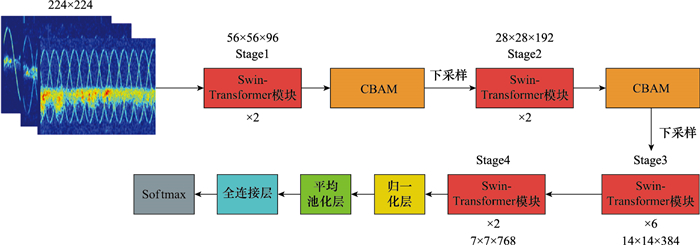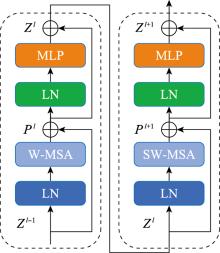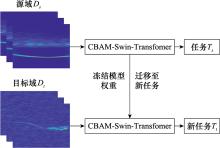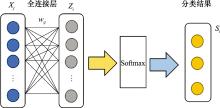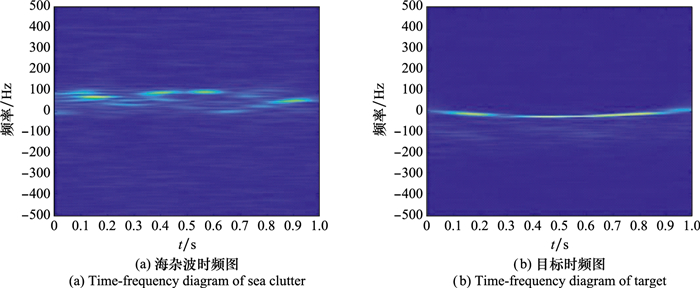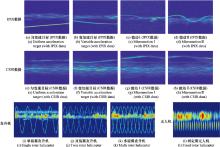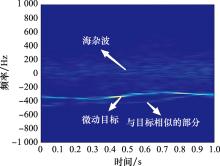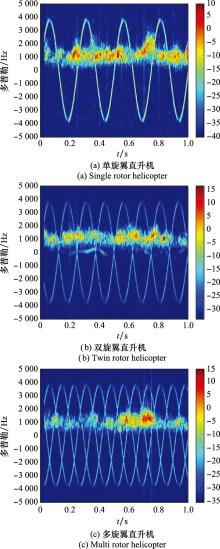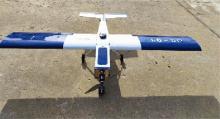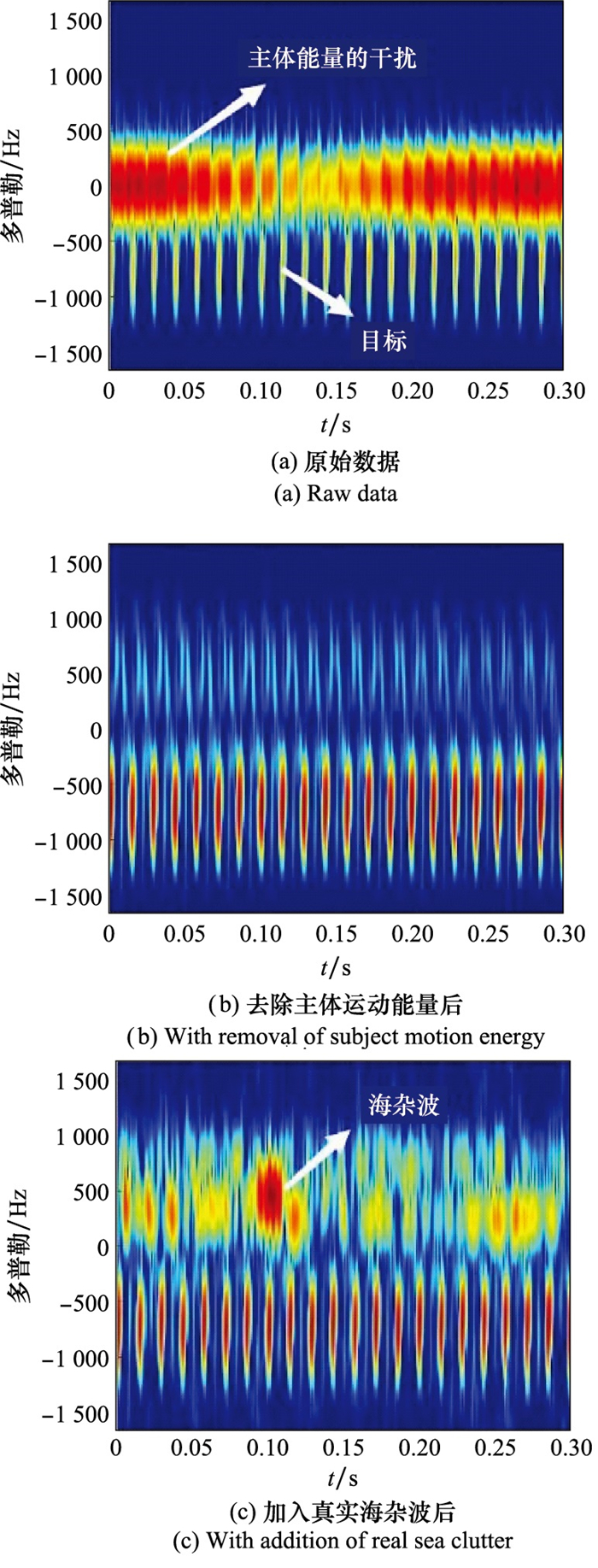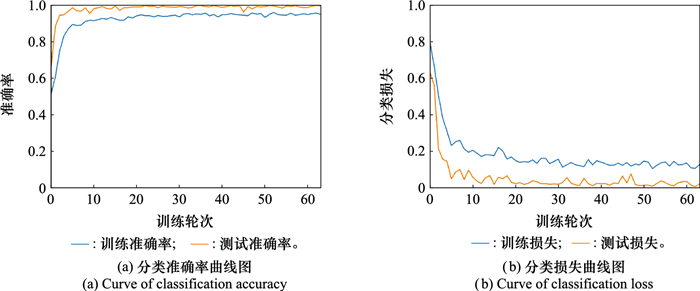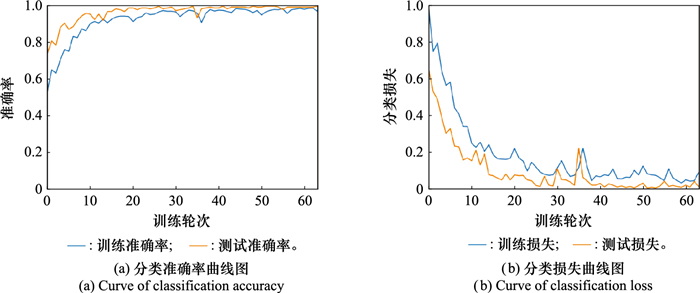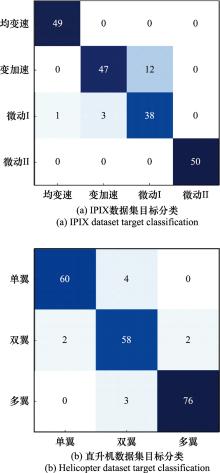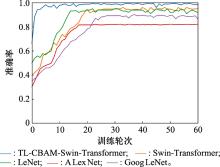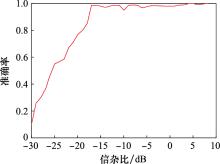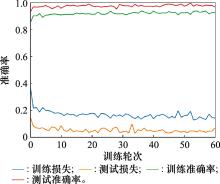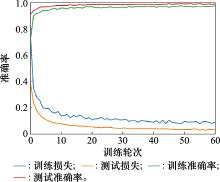Systems Engineering and Electronics ›› 2025, Vol. 47 ›› Issue (4): 1155-1167.doi: 10.12305/j.issn.1001-506X.2025.04.12
• Sensors and Signal Processing • Previous Articles Next Articles
Classification of maritime micromotion target based on transfer learning in CBAM-Swin-Transformer
Xiaoyang HE1, Xiaolong CHEN2,*, Xiaolin DU1, Ningyuan SU1, Wang YUAN1, Jian GUAN2
- 1. School of Computer and Control Engineering, Yantai University, Yantai 264005, China
2. Naval Aviation University, Yantai 264001, China
-
Received:2024-02-03Online:2025-04-25Published:2025-05-28 -
Contact:Xiaolong CHEN
CLC Number:
Cite this article
Xiaoyang HE, Xiaolong CHEN, Xiaolin DU, Ningyuan SU, Wang YUAN, Jian GUAN. Classification of maritime micromotion target based on transfer learning in CBAM-Swin-Transformer[J]. Systems Engineering and Electronics, 2025, 47(4): 1155-1167.
share this article
Table 1
Details of the dataset"
| 数据集种类 | 雷达类型 | 数据类型 | 训练集/张 | 测试集/张 | 目标种类 | 信噪比/dB |
| IPIX | X波段IPIX雷达[ | 实测海杂波+仿真目标 | 25 981 | 10 400 | 匀变速目标、变加速目标、微动Ⅰ、微动Ⅱ | [-30, 10] |
| CSIR | X波段CSIR雷达[ | 实测数据 | - | 1 000 | 匀变速目标、变加速目标、微动Ⅰ、微动Ⅱ | - |
| 直升机 | X波段雷达[ | 实测海杂波+仿真目标 | 1 200 | 1 040 | 单翼机、双翼机、多翼机 | [-20, 10] |
| 无人机 | Ku波段雷达[ | 实测数据 | - | 125 | 固定翼无人机 | [-5, 5] |
Table 2
Parameters related to IPIX dataset"
| 运动类型 | 初速度/(m/s) | 加速度/(m/s2) | 变加速度/(m/s3) | 角速度/(rad/s) | 微动周期/s | 采样点数 |
| 匀加速 | [-2, 10] | [-5, 5] | - | - | - | 210Hz, 1 s |
| 非匀变速 | [-5, 15] | [-5, 5] | [-8, 8] | - | - | 211 Hz, 0.5 s |
| 微动Ⅰ | - | - | - | ωx=[0.3, 0.38] ωy=[0.1, 0.15] ωz=[0.06, 0.08] | Tx=26.4 Ty=11.2 Tz=33.2 | 211 Hz, 0.5 s |
| 微动Ⅱ | - | - | - | ωx=[0.5, 0.58] ωy=[0.8, 0.95] ωz=[0.54, 0.58] | Tx=12.2 Ty=6.8 Tz=14.2 | 211Hz, 0.5 s |
| 12 | WANG X , ZHOU Y P , ZHOU D Q , et al. Research on low probability of intercept radar signal recognition using deep belief network and bispectra diagonal slice[J]. Journal of Electronics & Information Technology, 2016, 38 (11): 2972- 2976. |
| 13 |
KRIZHEVSKY A , SUTSKEVER I , HINTON G E . ImageNet classification with deep convolutional neural networks[J]. Communications of the ACM, 2017, 60 (6): 84- 90.
doi: 10.1145/3065386 |
| 14 | DENG J, DONG W, SOCHER R, et al. ImageNet: a large-scale hierarchical image database[C]//Proc. of the IEEE Conference on Computer Vision and Pattern Recognition, 2009: 248-255. |
| 15 | 苏宁远, 陈小龙, 关键, 等. 基于卷积神经网络的海上微动目标检测与分类方法[J]. 雷达学报, 2018, 7 (5): 565- 574. |
| SU N Y , CHEN X L , GUAN J , et al. Detection and classification of maritime target with micro-motion based on CNNs[J]. Journal of Radars, 2018, 7 (5): 565- 574. | |
| 16 | WANG J G , LI S B . Maritime radar target detection in sea clutter based on CNN with dual-perspective attention[J]. IEEE Geoscience and Remote Sensing Letters, 2022, 20, 3500405. |
| 17 | MENG X W . Rank sum nonparametric CFAR detector in nonhomogeneous background[J]. IEEE Trans. on Aerospace and Electronic Systems, 2021, 57 (1): 397- 403. |
| 18 | 李鑫, 陆伟, 马召祎, 等. 基于图注意力和改进Transformer的节点分类方法[J]. 电子学报, 2024, 52 (8): 2799- 2810. |
| LI X , LU W , MA Z Y , et al. A node classification method based on graph attention and improved transformer[J]. Acta Electronica Sinica, 2024, 52 (8): 2799- 2810. | |
| 19 | LIU Z, LIN Y T, CAO Y, et al. Swin transformer: hierarchical vision transformer using shifted windows[C]//Proc. of the IEEE/CVF International Conference on Computer Vision, 2021: 10012-10022. |
| 20 | LI Y . Review of application of transfer learning in medical image analysis[J]. Computer Engineering and Applications, 2021, 57 (20): 42- 52. |
| 21 | 张雪松, 庄严, 闫飞, 等. 基于迁移学习的类别级物体识别与检测研究与进展[J]. 自动化学报, 2019, 45 (7): 1224- 1243. |
| ZHANG X S , ZHUANG Y , YAN F , et al. Status and deve-lopment of transfer learning based category-level object recognition and detection[J]. Acta Automatica Sinica, 2019, 45 (7): 1224- 1243. | |
| 22 | ZHOU C C , ZHANG L K , ZENG G P , et al. Dispersed computing resource discovery model and algorithm for polymorphic migration network architecture[J]. Chinese Journal of Electronics, 2023, 32 (4): 821- 839. |
| 23 | QU Y Z , LIU W J , WANG J X , et al. Enhanced CNN-based small target detection in sea clutter with controllable false alarm[J]. IEEE Sensors Journal, 2023, 23 (9): 10193- 10205. |
| 24 | GUO C, WANG H P, XIA X Z, et al. Deep transfer learning based method for radar automatic recognition with small data size[C]//Proc. of the IEEE International Conference on Unmanned Systems, 2021: 995-999. |
| 25 | 任硕良, 索继东, 佟禹. 卷积神经网络结合迁移学习的SAR目标识别[J]. 电光与控制, 2020, 27 (10): 37- 41. |
| REN S L , SUO J D , TONG Y . SAR target recognition based on convolution neural network and transfer learning[J]. Electronics Optics & Control, 2020, 27 (10): 37- 41. | |
| 26 | 陈小龙, 董云龙, 李秀友, 等. 海面刚体目标微动特征建模及特性分析[J]. 雷达学报, 2015, 4 (6): 630- 638. |
| CHEN X L , DONG Y L , LI X Y , et al. Modeling of micromotion and analysis of properties of rigid marine targets[J]. Journal of Radars, 2015, 4 (6): 630- 638. | |
| 27 | 李宇倩, 易建新, 万显荣, 等. 外辐射源雷达直升机旋翼参数估计方法[J]. 雷达学报, 2018, 7 (3): 313- 319. |
| LI Y Q , YI J X , WAN X R , et al. Helicopter rotor parameter estimation method for passive radar[J]. Journal of Radars, 2018, 7 (3): 313- 319. | |
| 1 | XU S W , ZHENG J B , PU J , et al. Sea-surface floating small target detection based on polarization features[J]. IEEE Geoscience and Remote Sensing Letters, 2018, 15 (10): 1505- 1509. |
| 2 | 陈小龙, 关键, 何友. 微多普勒理论在海面目标检测中的应用及展望[J]. 雷达学报, 2013, 2 (1): 123- 134. |
| CHEN X L , GUAN J , HE Y . Applications and prospect of micro-motion theory in the detection of sea surface target[J]. Journal of Radars, 2013, 2 (1): 123- 134. | |
| 3 | 罗迎, 张群, 王国正, 等. 基于复图像OMP分解的宽带雷达微动特征提取方法[J]. 雷达学报, 2012, 1 (4): 361- 369. |
| LUO Y , ZHANG Q , WANG G Z , et al. Micro motion signature extraction method for wideband radar based on complex image OMP decomposition[J]. Journal of Radars, 2012, 1 (4): 361- 369. | |
| 4 | LI Y M , WU R B , BAO Z , et al. Inverse synthetic aperture radar imaging of ship target with complex motion[J]. IET Radar, Sonar & Navigation, 2008, 2 (6): 395- 403. |
| 5 |
HAJDUCH G , LE-CAILLEC J M , GARELLO R . Airborne high-resolution ISAR imaging of ship targets at sea[J]. IEEE Trans. on Aerospace and Electronic Systems, 2004, 40 (1): 378- 384.
doi: 10.1109/TAES.2004.1292177 |
| 6 |
CHEN X L , GUAN J , BAO Z H , et al. Detection and extraction of target with micromotion in spiky sea clutter via short-time fractional Fourier transform[J]. IEEE Trans. on Geoscience and Remote Sensing, 2014, 52 (2): 1002- 1018.
doi: 10.1109/TGRS.2013.2246574 |
| 7 | CHEN X L , GUAN J , LI X Y , et al. Effective coherent integration method for marine target with micromotion via phase differentiation and radon- Lv's distribution[J]. IET Radar, Sonar & Navigation, 2015, 9 (9): 1284- 1295. |
| 8 |
WAGNER S A . SAR ATR by a combination of convolutional neural network and support vector machines[J]. IEEE Trans. on Aerospace and Electronic Systems, 2016, 52 (6): 2861- 2872.
doi: 10.1109/TAES.2016.160061 |
| 9 |
KIM Y , TOOMAJIAN B . Hand gesture recognition using micro-doppler signatures with convolutional neural network[J]. IEEE Access, 2016, 4, 7125- 7130.
doi: 10.1109/ACCESS.2016.2617282 |
| 10 | 王俊, 郑彤, 雷鹏, 等. 深度学习在雷达中的研究综述[J]. 雷达学报, 2018, 7 (4): 395- 411. |
| WANG J , ZHENG T , LEI P , et al. Survey of study on deep learning in radar[J]. Journal of Radars, 2018, 7 (4): 395- 411. | |
| 11 | 徐彬, 陈渤, 刘宏伟, 等. 基于注意循环神经网络模型的雷达高分辨率距离像目标识别[J]. 电子与信息学报, 2016, 38 (12): 2988- 2995. |
| XU B , CHEN B , LIU H W , et al. Attention-based recurrent neural network model for radar high-resolution range profile target recognition[J]. Journal of Electronics & Information Technology, 2016, 38 (12): 2988- 2995. | |
| 12 | 王星, 周一鹏, 周冬青, 等. 基于深度置信网络和双谱对角切片的低截获概率雷达信号识别[J]. 电子与信息学报, 2016, 38 (11): 2972- 2976. |
| 28 | 万磊, 佟鑫, 盛明伟, 等. Softmax分类器深度学习图像分类方法应用综述[J]. 导航与控制, 2019, 18 (6): 1-9, 47. |
| WAN L , TONG X , SHENG M W , et al. Review of image classification based on Softmax classifier in deep learning[J]. Navigation and Control, 2019, 18 (6): 1-9, 47. | |
| 29 | 陈小龙, 关键, 何友, 等. 高分辨稀疏表示及其在雷达动目标检测中的应用[J]. 雷达学报, 2017, 6 (3): 239- 251. |
| CHEN X L , GUAN J , HE Y , et al. High-resolution sparse representation and its applications in radar moving target detection[J]. Journal of Radars, 2017, 6 (3): 239- 251. | |
| 30 | 陈小龙, 袁旺, 杜晓林, 等. 多波段FMCW雷达低慢小探测数据集(LSS-FMCWR-1.0)及高分辨微动特征提取方法[J]. 雷达学报(中英文版), 2024, 13 (2): 539- 553. |
| CHEN X L , YUAN W , DU X L , et al. Multiband FMCW radar LSS-target detectiondataset (LSS-FMCWR-1.0) and high-resolution micromotion feature extraction method[J]. Journal of Radars, 2024, 13 (3): 539- 553. | |
| 31 | 李振春, 刁瑞, 韩文功, 等. 线性时频分析方法综述[J]. 勘探地球物理进展, 2010, 33 (4): 239- 246. |
| LI Z C , DIAO R , HAN W G , et al. Review on linear time-frequency analysis methods[J]. Progress in Exploration Geophysics, 2010, 33 (4): 239- 246. | |
| 32 | 胡松, 江小炜, 杨光, 等. 滑动平均滤波在微弱脉冲信号检测中的应用[J]. 计算机与数字工程, 2007, 35 (10): 169- 171. |
| HU S , JIANG X W , YANG G , et al. Using of moving average filter in faint pulse signal detection[J]. Computer and Digital Engineering, 2007, 35 (10): 169- 171. |
| [1] | Xiaoyang HE, Xiaolong CHEN, Xiaolin DU, Ningyuan SU, Wang YUAN, Jian GUAN. Classification of maritime micromotion target based on transfer learning in CBAM-Swin-Transformer [J]. Systems Engineering and Electronics, 2025, 47(4): 1155-1167. |
| [2] | Qianqi NIE, Minghui SHA, Yingshen ZHU, Chongyu WANG, Nianqiang CUI. Radar multi-component signal recognition method based on blind source separation combined with singular spectrum analysis [J]. Systems Engineering and Electronics, 2025, 47(4): 1168-1175. |
| [3] | Jiakuan LI, Bo FENG, Hongliang LIU, Chunmao YE, Jizhou YU. Angle-guided attention-based wideband PD recognition method for aerodynamic targets [J]. Systems Engineering and Electronics, 2025, 47(3): 807-816. |
| [4] | Qiang AN, Chunmao YE, Yaobing LU, Yan ZHANG. Interrupted sampling repeater jamming suppression algorithm in complex scenarios [J]. Systems Engineering and Electronics, 2025, 47(2): 463-477. |
| [5] | Qiang LIU, Haoran SUN, Denghua HU, Shuang ZHANG. Time alignment fusion algorithm based on Vondrak-Cepek combined filtering and attention mechanism weighting [J]. Systems Engineering and Electronics, 2025, 47(2): 673-679. |
| [6] | Ruibin ZHANG, Mengtao ZHU, Yunjie LI. Radar transmitting signal generation method for modulation recognition network stealth [J]. Systems Engineering and Electronics, 2024, 46(7): 2256-2268. |
| [7] | Yuming HUA, Dongya WANG, Tianlin ZHU, Sheng JIN, Yang WANG. Time-frequency harmonic wave analysis method of composite micro-Doppler signals [J]. Systems Engineering and Electronics, 2024, 46(7): 2301-2309. |
| [8] | Jiajun WU, Chun SU, Yuru ZHANG. Remaining useful life prediction based on double self-attention mechanism and long short-term memory network [J]. Systems Engineering and Electronics, 2024, 46(6): 1986-1994. |
| [9] | Lisha XUE, Ruixing GE, Yuxuan ZHU, Yanfei BAO. Generation and efficiency analysis of communication jamming signal based on SABEGAN [J]. Systems Engineering and Electronics, 2024, 46(6): 2155-2163. |
| [10] | Shaohua LIU, Kang DU, Chundong SHE, Ao YANG. Multi-teacher joint knowledge distillation based on CenterNet [J]. Systems Engineering and Electronics, 2024, 46(4): 1174-1184. |
| [11] | Xiaoyu FANG, Lijia HUANG. SAR ship detection algorithm based on global position information and fusion of residual feature [J]. Systems Engineering and Electronics, 2024, 46(3): 839-848. |
| [12] | Chunjie ZHANG, Guanbo WANG, Qi CHEN, Zhi'an DENG. Gesture recognition based on millimeter-wave radar with pure self-attention mechanism [J]. Systems Engineering and Electronics, 2024, 46(3): 859-867. |
| [13] | Qianqi NIE, Minghui SHA, Yingshen ZHU. Radar signal recognition method based on improved residual neural network [J]. Systems Engineering and Electronics, 2024, 46(10): 3356-3364. |
| [14] | Xiaofeng ZHAO, Jiahui NIU, Chuntong LIU, Yuting XIA. Hyperspectral image classification based on hybrid convolution with three-dimensional attention mechanism [J]. Systems Engineering and Electronics, 2023, 45(9): 2673-2680. |
| [15] | Haijun LI, Fancheng KONG, Yun LIN. Infrared ship detection algorithm based on improved YOLOv5s [J]. Systems Engineering and Electronics, 2023, 45(8): 2415-2422. |
| Viewed | ||||||
|
Full text |
|
|||||
|
Abstract |
|
|||||



